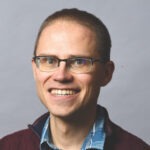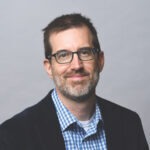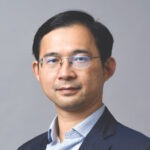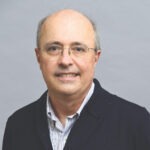This story was written by Adam Hadhazy, and originally appeared in the Winter 2022 edition of the Johns Hopkins Whiting School of Engineering Magazine.
The world is transitioning to clean, renewable, sustainable energy—and fast. Consider this: In 2021, more than 90 percent of all the new electricity generation added around the world came from renewables like solar and wind, according to the International Renewable Energy Agency.
To see how renewable energy is on a roll, look no further than Johns Hopkins University. After committing in 2008 to slash greenhouse gas emissions by 51% by 2025, the university is now set to hit that target a full three years early, thanks to a substantial investment in off-site solar energy.
Yet as heady as all that news is, it comes at a time of ever-increasing climatic peril. To wit, consider a multiple-choice question: Of the 10 hottest years on record, how many occurred in the last 10 years? A) zero, B) one, C) five, or D) nine.
The answer — alarmingly — is D.
The fate of Earth’s climate, and quite possibly that of modern, industrialized humanity as we know it, hinges on the far-bigger question of how many degrees our planet ultimately warms this century. Since 1880, the pumping of heat-trapping greenhouse gases (primarily carbon dioxide) into the atmosphere through humankind’s burning of fossil fuels has already warmed the world by 1 degree Celsius (2 degrees Fahrenheit). The 2015 Paris Agreement set a goal of limiting the total rise to 2 C (3.6 F) above pre-industrial levels, while recognizing that the avoidance of climate change’s most dire impacts means shooting for 1.5 C (2.7 F). Achieving either of these ambitious but critical goals mean somehow accelerating renewable energy’s development and adoption far faster than even its current clip.
To help supercharge the ongoing energy transition, this past Earth Day, Johns Hopkins University and the Whiting School of Engineering announced the creation of the Ralph S. O’Connor Sustainable Energy Institute. Initialized as ROSEI and pronounced “rosy,” the new institute serves as an interdisciplinary home at Johns Hopkins for ongoing research and education. In a multipronged approach, ROSEI is bringing technical researchers together with social scientists university-wide to create and implement scalable, renewable energy technologies.
“Embedded in the mission of the institute is trying to make things better for the world by focusing on a problem we’re all facing now, which is the need for transitioning our energy use,” says ROSEI Director Ben Schafer, who is the Willard and Lillian Hackerman Professor of Civil and Systems Engineering at the Whiting School.
The urgency grows greater by the day. In August, the United Nations-led Intergovernmental Panel on Climate Change, which has convened since the late 1980s, issued a new report authored by hundreds of international climate scientists. In some of the starkest language ever to appear in IPCC reports, the scientists wrote that it is “unequivocal that human influence has warmed the atmosphere, ocean and land.” This warming is “already affecting many weather and climate extremes in every region across the globe,” observable “in extremes such as heatwaves, heavy precipitation, droughts, and tropical cyclones.”
“What’s new in the latest IPCC report is that [climate change’s] warming impacts are worse and happening faster than we thought,” says Johannes Urpelainen, a ROSEI researcher and the Prince Sultan bin Abdulaziz Professor of Energy, Resources and Environment at the Paul H. Nitze School of Advanced International Studies. “We’re already in a situation where we might blow past the 1.5 degrees Celsius mark in only 10 years, in the early 2030s. And that’s scary. It means we need to urgently act.”
A Renewed Push for Renewables

Windmill for electric power production, Burgos Province, Castilla Leon, Spain.
Schafer and Urpelainen are two of ROSEI’s seven Leadership Council members, each of whom has contributed to bringing the institute to fruition and continues to guide initial investments.
ROSEI was made possible by a $20 million gift from the estate of trustee emeritus and alumnus Ralph S. O’Connor ’51, and will serve as the catalyst of a new $75 million, 10-year total investment by the Whiting School and the university in energy-related research and education.
An entrepreneur, civic leader, and philanthropist, O’Connor gave generously to Johns Hopkins for decades, providing financial aid, endowed faculty chairs, athletics, art, awards for undergraduate entrepreneurs, and facilities. Tying in with ROSEI’s mission, a Homewood campus recreation center named after O’Connor is part of the largest solar installation on campus, boasting nearly 1,400 solar panels on its roof and that of the adjacent Newton White Athletic Center.
Besides the Leadership Council, an initial slate of 26 faculty members is affiliated with ROSEI, collectively bridging a rich array of disciplines. Expanding its expertise and influence, ROSEI will also partner with other Johns Hopkins divisions, including the Applied Physics Laboratory, the Bloomberg School of Public Health, and the School of Advanced International Studies, as well as government agencies in the Washington, D.C., area.
Schafer explains that ROSEI is organized so that roughly two-thirds of its resource allocation and activities will center on enabling technologies for renewable energy. Within that realm, wind and solar are the primary areas for ROSEI faculty members, along with transforming conventional fossil fuel use. The remaining one-third of ROSEI’s overall efforts will center on equitable implementation, zeroing in on the energy policy, marketplace development, and education that will need to happen for sustainable energy to successfully turn the tide against climate change.
“We’re trying to attack the full breadth of the problem,” says Schafer.
“ROSEI is a unique way for Johns Hopkins to lead in addressing the challenges in sustainability in an interdisciplinary way,” says Chao Wang, associate professor of chemical and biomolecular engineering, and an affiliated researcher in ROSEI. “We want to be very synergistic, taking advantage of what people here on campus are good at.”
Susanna Thon, associate professor of electrical and computer engineering, and a member of the ROSEI Leadership Council, adds, “We’re reimagining renewable energy at Johns Hopkins by connecting all these researchers together and building something bigger than the sum of its parts.”
Capturing the Sun’s Blaze

Power plant using renewable solar energy with sun.
For their part, Thon and her group at Johns Hopkins are looking to revolutionize today’s solar power by expanding the range of light it can collect and where its energy-reaping cells could go. The solar story so far has been one of great success, surging from about 1 gigawatt of capacity worldwide in 2000 to knocking on the door of 1 terawatt (1,000 gigawatts) today. (One gigawatt is enough to power approximately 250,000 average homes.)
That said, solar has significant room for improvement. For instance, conventional, photovoltaic solar power — provided by those rigid, blue-grayish panels arrayed in fields and on rooftops — has relied on the element silicon. As a semiconductor, silicon absorbs sunlight and transfers some of its energy to particles called electrons, the flow of which comprises electricity. The widely available commercial panels of today possess solar cells with about a 20% efficiency rate, meaning they convert 20% of the sunlight that strikes them into usable electricity, with much of the rest lost as heat. Even with anticipated advances, however, the theoretical maximum for conventional silicon cells tops out around 30% efficiency. “We’re close, and that’s it for silicon,” says Thon. The efficiency of traditional solar panel also drops precipitously for light coming in at angles.
Thon’s group at Johns Hopkins is looking to address both issues. A key approach is manipulating materials at the nanoscale level, at mere billionths of a meter, in order to produce novel properties. For instance, so-called quantum dots — nano-specs of semiconductor material — can be grown to differing sizes and arranged to capture more colors of sunlight than bulk silicon, thus reaping energy more efficiently.
Another approach along these lines is to devise solar cells that only absorb infrared light but let visible through. Panels made of this material would be nearly invisible and thus could go right over windows, greatly expanding places where solar generation can occur. One such place is glazing windows, especially of cars, trucks, and other transportation vehicles, which are still dominantly powered by fossil fuels and represent a tremendous source of global carbon emissions.
Thon and her close colleagues are collaborating with other engineers and chemists across the university to realize all this potential. “I’ve already met lots of people at other schools at Johns Hopkins through ROSEI,” says Thon, “and it’s much easier when you have this entity that forms these natural connections.”
Reaping the Wind
Like solar, wind power has also done smashingly. Only around 20 gigawatts of capacity were in place worldwide in 2000, and with well over 700 gigawatts currently installed, according to the Global Wind Energy Council, wind is likewise knocking on terawatt’s door. Both generation technologies have plummeted in cost per watt and are now cheaper than traditional coal-fired and natural gas-fueled power stations.
At the heart of wind power is the turbine, usually a vertical pole with three affixed blades. When it comes to engineering individual blades and stand-alone turbine units, wind power technology has already been highly optimized, says Charles Meneveau, the Louis M. Sardella Professor of Mechanical Engineering at the Whiting School and an affiliated faculty member at ROSEI. Turbines keep getting bigger and more powerful, with the world’s largest soaring over 800 feet tall, in shouting distance of the approximately 1,000-foot-tall Eiffel Tower. Regarding today’s colossal turbine, “imagine an Eiffel Tower that moves,” says Meneveau. Blades can run nearly the length of a Boeing 737, whip around close to 200 miles per hour, and sweep out an area the size of several football fields.
While bigger and more turbines equate to more power, there remains serious untapped energy-generating potential in better understanding the dynamics of how turbines in vast farms influence each other, as the incoming winds and other meteorological conditions inevitably vary. “We’re talking about gigantic machines interacting with the environment at scales we’re not used to,” says Meneveau. “I think we’ve just started scratching the surface of a lot of improvements.”
Meneveau’s specialty is studying hydrodynamic turbulence, that which occurs in wind farms as a gust flows through a lead turbine’s blades, is weakened, and then flows through another nearby turbine. Meneveau and colleagues computationally model this fluid mechanical complexity, and their findings have already advanced turbine array arrangement designs. A new goal of the ongoing research is to democratize the information, Meneveau says, by making not only the results and insights publicly accessible but also the full-scale simulation data themselves. “We’re working on distributing outstanding data and analysis to the world,” he says.
A close colleague of Meneveau’s in these matters of maximizing wind energy is ROSEI Leadership Council member Dennice Gayme, associate professor of mechanical engineering and the Carol Croft Linde Faculty Scholar at the Whiting School.
Gayme focuses on understanding the impact of turbulence, atmospheric flow, and designing wind farm control and grid integration strategies to ensure that the wind farm efficiently delivers steadier, predictable, and more usable power to the electrical grid. Computational models that Gayme, Meneveau, and colleagues have recently developed can more accurately predict the power output from farms, thus optimizing turbine placement in the design stage. They have also shown that dynamic models that take these factors into account enable wind farms to participate in grid services. Gayme is also looking to build models that incorporate more forecasting to understand power output potential and improve real-time adjustments of turbine operations.
Furthering their work, Gayme and Meneveau have received a grant through ROSEI to model the effects of the motion imparted to turbines as waves roll through offshore wind farms. The upshot should be performance gains that really add up over years of energy production. “This research is at the cutting edge of using mathematical tools to better understand variability in the environment,” says Gayme.
- Johannes Urpelainen
- Ben Schafer
- Chao Wang
- Dennice Gayme
- Charles Meneveau
- Susanna Thon
Finding Sustainability in the Unsustainable

Offshore windmill park alternative energy. Windmills in the sea with reflection in the morning, Denmark
For all the progress renewables have made — and will continue to make, courtesy of the advances pursued by ROSEI researchers — fossil fuels will assuredly remain humanity’s primary sources of electricity generation and transportation fuel for years to come. Accordingly, a major thrust at ROSEI is developing technologies that curb fossil fuels’ impacts.
“Fossil fuel use is going to be around for a while still,” says Schafer, “so we need technologies that help take away the danger and actually make something useful for us.”
Wang, the ROSEI-affiliated chemical engineer, is spearheading multiple efforts toward this end. One focus is on the capture of carbon dioxide from air, followed by conversions into value-added products. His group is developing novel thermo- and electrochemical technologies to enable direct air capture, or DAC. The technology features the use of Earth-abundant materials, robust acid-base chemistries, and renewable but intermittent energy sources, such as solar and wind electricity. By substantially improving the energy efficiency, Wang’s group is targeting DAC at costs lower than $100 per metric ton of captured carbon dioxide, a threshold for commercial implementation.
Rather than storing captured carbon in underground reservoirs, as has been widely proposed, Wang’s group is also exploring how to cost-effectively convert the captured carbon dioxide into useful products, such as chemicals, fertilizers, and structural materials. “There are a lot of things we’re working on with carbon-based chemicals and materials,” says Wang. “Our ultimate goal is to fix the carbon for a long lifetime so that we can offset the trend of accumulating carbon in the atmosphere.”
In a similar vein, Wang’s group is conducting research into catalytic upcycling of end-of-life plastics. The concept: Convert solid waste plastics into liquid feedstocks for useful chemicals — essentially what the petrochemical industry already does, but in reverse. “Discarded hard plastics can be a source of hydrocarbons, just like crude oil,” says Wang. “The difference is one source is solid, the other is liquid.”
Wang’s group is focused on low-quality, valueless plastic wastes — #3–7 mixtures, including grocery bags and packing peanuts — that hardly ever get recycled and accordingly end up in landfills and in the ocean, where they cause contamination to soil, water, and wildlife. The researchers already have demonstrated how these plastics, even when mixed up with regular household food trash and yard waste, can be readily transformed into aromatic compounds such as xylene, which has high industrial value. The group now plans to set up a pilot facility in Chao’s lab on Johns Hopkins’ campus to process 1 kilogram a day of plastic waste. In parallel, talks are underway with Maryland authorities and local waste management companies about establishing a pilot plant off Johns Hopkins’ campus to process 1 ton per day, starting perhaps as soon as next year.
“We’ve already done the fundamental science,” says Wang. “Now we’re pushing toward commercialization.”
Into the Real World
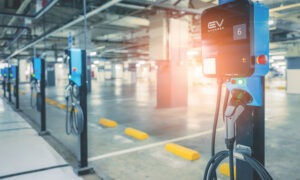
Blurred electric car charging station for charge EV battery. Plug for vehicle with electric engine. EV charger. Clean energy. Charging point at car parking lot. Future transport technology.
Getting renewable and sustainable energy technologies, like Wang’s plastics upcycling, out of the lab, into the real world, and scaled up in an equitably beneficial way is the second major thrust of ROSEI. Urpelainen is a key player in this regard. He brings his expertise in energy policy research and international issues relating to climate change and the transition to renewable energy.
“ROSEI has a strong technical foundation but also has a clear interest in broader issues in society, like equity and feasibility of implementation,” says Urpelainen. “Our purpose is, ‘How do we take these wonderful technologies we’re developing and use them to encourage sustainable energy production and consumption across the global energy system?’”
The implementation challenge is multifaceted, from gaining social acceptance and government support to developing markets where interested parties are incentivized to build out renewable energy — especially of the inventive, reimagined technologies ROSEI’s researchers will have to offer.
Befitting the enterprising spirit of the institute, ROSEI will initially operate out of the second floor of FastForward R. House, a Johns Hopkins Technology Ventures innovation hub near the Homewood campus.
“Through ROSEI, we will have sustainable, energy-related activities and efforts across all levels, from high school outreach to our undergraduate and graduate students, and from our postdocs and research scientists to young faculty and senior faculty,” says Schafer.
As part of broadening academic opportunities at the university, Johns Hopkins is boosting energy-related curricula, including a potential minor program in energy. “The university is showing a commitment to attracting the best students,” says Thon, “and the current students are thrilled about the new academic resources that will be available to them.”
ROSEI-affiliated faculty members have seen firsthand how the intertwined topics of renewable, sustainable energy, and the pan-national, generational fight against climate change resonate with their students. “It’s the critical challenge of our world,” says Thon.
“Our students are getting more and more interested in this area,” adds Gayme. “That’s why it’s so important having a home for this research at Hopkins with ROSEI.”
“For the students, it’s so new and exciting,” says Meneveau. “They have the sense that they might contribute to changing things for the better.”

